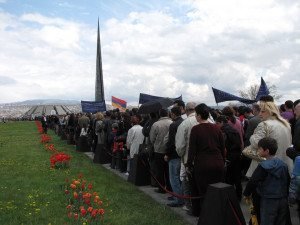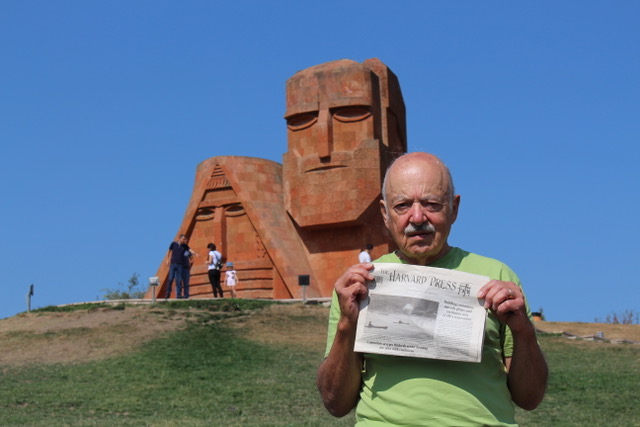Evening, April 23, Yerevan: This is the first time I’ve been in Armenia around April 24. On the evening of the 23rd I joined a youth march heading up Baghramyan Street towards Tsitsernakabert, the Armenian Genocide Memorial situated atop a hill in Yerevan. The march was organized by the ARF and consisted mostly of young Armenians in their teens and 20’s. I linked up with Razmik, a gentleman about my age. It was damp and windy, with drizzle occasionally turning into rain and then to drizzle again. The youth carried candles and signs in multiple languages demanding genocide recognition and thanking those nations that recognized the genocide. There were continual chants of “janachoom” (recognition). As we marched up the hill towards the memorial it started to get dark. Yerevan appeared below with the mountains to the north silhouetted against occasional lightning flashes on the other side of the mountains. On top, at the memorial, the youth and clergy were gathered, carrying Armenian flags, with prayers for the martyrs and speeches.

Suddenly there emerged from the crowd two to three youth with a video camera and a microphone; they asked me, in Armenian, if they could interview me. I replied affirmatively but stated that my Armenian was not perfect, at which point they indicated I could speak English. Almost simultaneously my new friend Razmik and I shouted “No, Armenian!” I was asked if I came especially to attend the April 24 memorial ceremonies and I replied, “No, I came to be in Armenia but I was extremely glad to be here on April 24.” This was so unexpected that I honestly don’t remember much of the rest of the interview. A day or two later, a friend called my wife’s cousin in Yerevan and asked, “Is Joe here in Armenia?” He had seen my interview on TV. Later in Gyumri, friends told me that they had seen the interview, and a friend here in Waltham called my wife (who was also in Massachusetts) to tell her that she saw me on Armenian TV, which she receives via cable or satellite.
April 24, Yerevan: I had thought that the streets heading to Tsitsernakabert would be full of crowds heading to the Genocide Memorial. It was not quite like that. But as one got closer to the memorial, there were more and more flower vendors and pedestrians. Traffic increased until, at the base of the hill on which the memorial is situated, the walkways were jammed packed. At the base of the hill, a booth was distributing flowers for free just in case someone could not afford to buy flowers. Around noon, which is when I arrived, a sea of humanity was moving slowly and calmly up the hill towards the memorial. It took well over an hour and a half to ascend the hill. Normally it is about a 10 minute walk. Mt. Ararat, which was clearly visible in the morning, was now obscured in haze. The peaks of Mt. Aragats and other surrounding mountains gleamed sparkling white with newly fallen snow. The weather was both warm and cool, depending on the sun and the direction of the light breeze. Marchers varied from very young to very old, with many young children perched upon the shoulders of their parents. As far as one could see in either direction, there was a sea of people slowly marching, talking with friends or with their children, with flowers in hand. Much of the conversation was about the genocide, or Western Armenia. Sharagans (church hymns) softly flowed from loud speakers along the way.
As I left the walkway to take some photographs, a woman called to me by name. She is a dear friend of ours, a Karabaghtsi woman whose husband was a volunteer commander in Karabagh and helped liberate Shushi. She had fled various villages, arriving in Stepanakert the day before Azerbaijan started bombing the city. At dinner with them a couple of years ago, her husband showed us photographs of his group—many of whom were martyred. When he reluctantly showed us his medals, my wife mentioned to his two beautiful children how proud they must be of their father. He solemnly turned to us and said, “We did not fight for medals. All the medals in the world are not worth the life of one of my soldiers.” He continued, “War is such a waste. I don’t know why people can’t settle things peacefully. But when your country needs you, you go and help.”
At the top of the hill, the police periodically closed the entrance into the memorial to allow those inside to leave and make room for the next group of visitors. People placed flowers around the periphery of the eternal flame. Upon exiting a young mother said to her three-year-old child, “You did well, paying tribute to our martyrs.”
Around the outside of the memorial, various organizations placed large wreaths of flowers. The United States Embassy sent a wreath as well. I was disturbed that the ribbon attached to the wreath contained the message “To the Republic of Armenia.” I believe the flowers should have been in the memory of the victims of the Armenian Genocide. I wonder, was this an attempt to be “politically correct” while at the same time avoiding genocide acknowledgement?
At around 7 p.m. that evening, I went to Tsitsernakabert again. The flow of people paying their respect was still going strong. The wall of flowers placed around the eternal flame was well above my head. On the way up to the memorial, thoughts went back to survivors I had known. My grandmother survived the 1896 massacres. Members of our church, ARS, and ARF, now departed, were survivors. That generation in my wife’s family helped in the struggle for Armenian independence. I wish they all could see a free and independent, though still imperfect, Armenia. It’s our job to perfect it and see that justice is finally achieved.
April 25, Yerevan: The Genocide commemoration was over, or was it? People were still discussing the genocide. In every conversation I had, the person I was talking to brought up the genocide issue, recognition, and compensation. People asked me if I’ve seen certain movies and documentaries regarding the genocide. Taxi drivers initiated discussions about Van, Erzerum, and Moush. People were angry at President Obama for betraying his promise to acknowledge the genocide. They were disappointed in the United States. Many said that though they were initially hopeful about Obama, the administration had demonstrated that it is no different than its predecessors. People were particularly upset with Armenian President Serge Sarkisian for signing the “road map” for normalizing relations with Turkey—just two days before April 24. This, they said, gave Obama every excuse for reneging on his genocide recognition promise. If the “road map” was to be signed, they said, it should have been done after April 24 and after Obama’s statement.
A few days after, I was at a border village in southern Armenia. A wonderful family invited us in for than (yogurt drink), coffee, and dinner. We accepted the invitation for tahn and coffee. I asked how the economy in the village was and they said it was not good, but that “We’ll survive.” This is a particularly common response among tough, determined villagers. I asked if the economy would improve if the border was opened, and they replied that it probably would improve somewhat, but then added, “We don’t care, we want genocide recognition first.”
The following week, in Karabagh, we stopped for coffee in a small village. Immediately one of the women at the rest stop approached me and asked “Do you like Obama?”
“I did, until a week ago” I replied.



Be the first to comment